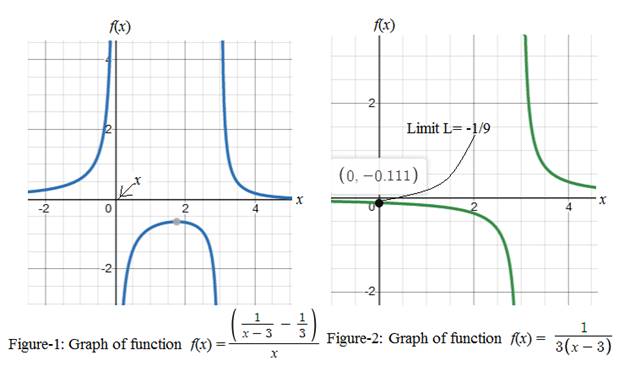
Concept explainers
Toevaluate:Theevaluation of the limit
Answer to Problem 32CLT
The limit exists as
Explanation of Solution
Given information:
The given limit is
Formulaused:
Let f be a function
Calculations:
The given limit is
Thus, the limit
Verification of limit with graph:
The graph of function

From the graph, we observe that when
Chapter 12 Solutions
Precalculus with Limits
- Use the following graphs to evaluate the given one-sided limit. Answer exactly. y = f (x): y = g(x): 8 6 ν -8-6-4-2 2- 1-2-2 -4 -6 -8 ° 4 lim (f(x)+g(x)) = x+2+ 8 6 2 ν 0 x x 6 8 -8 -6-4-2 2 6 8 -2 -4 -6 -8arrow_forwardQuestion 1 The points A = (-2, 3, 2) and B = (4, 1, 4) are reflections of one another in a plane S. Find an equation for S.arrow_forwardThe graph below is the function f (x) -D -3-2 4 3 2 Q2 03 Find lim f(x) = x-1- Find lim f(x) = x−1+ Find lim f(x) = x-1 Find f (-1) = 3 4 5arrow_forward
- i circled the correct answer and i did most of the question but i cant figure out how to add both residues to get the correct answer could you please show me how to do itarrow_forwardQuestion 3 Starting at the point (0, −2,0), I walk up the hill z = 4-x² — y². The projection of my path on the xy plane is the line y = 2x-2. (a) At what point on my path is my altitude (the z-value) the greatest? (b) What is the slope m of my path (taking the z-axis to be vertical) when I am at the point (1, 0, 3)? [Hint: Parametrize my path (take x to be t).]arrow_forwardI circled the correct, could you explain using stokearrow_forward
- Use Euler's method to numerically integrate dy dx -2x+12x² - 20x +8.5 from x=0 to x=4 with a step size of 0.5. The initial condition at x=0 is y=1. Recall that the exact solution is given by y = -0.5x+4x³- 10x² + 8.5x+1arrow_forwardFind an equation of the line tangent to the graph of f(x) = (5x-9)(x+4) at (2,6).arrow_forwardFind the point on the graph of the given function at which the slope of the tangent line is the given slope. 2 f(x)=8x²+4x-7; slope of the tangent line = -3arrow_forward
 Calculus: Early TranscendentalsCalculusISBN:9781285741550Author:James StewartPublisher:Cengage Learning
Calculus: Early TranscendentalsCalculusISBN:9781285741550Author:James StewartPublisher:Cengage Learning Thomas' Calculus (14th Edition)CalculusISBN:9780134438986Author:Joel R. Hass, Christopher E. Heil, Maurice D. WeirPublisher:PEARSON
Thomas' Calculus (14th Edition)CalculusISBN:9780134438986Author:Joel R. Hass, Christopher E. Heil, Maurice D. WeirPublisher:PEARSON Calculus: Early Transcendentals (3rd Edition)CalculusISBN:9780134763644Author:William L. Briggs, Lyle Cochran, Bernard Gillett, Eric SchulzPublisher:PEARSON
Calculus: Early Transcendentals (3rd Edition)CalculusISBN:9780134763644Author:William L. Briggs, Lyle Cochran, Bernard Gillett, Eric SchulzPublisher:PEARSON Calculus: Early TranscendentalsCalculusISBN:9781319050740Author:Jon Rogawski, Colin Adams, Robert FranzosaPublisher:W. H. Freeman
Calculus: Early TranscendentalsCalculusISBN:9781319050740Author:Jon Rogawski, Colin Adams, Robert FranzosaPublisher:W. H. Freeman
 Calculus: Early Transcendental FunctionsCalculusISBN:9781337552516Author:Ron Larson, Bruce H. EdwardsPublisher:Cengage Learning
Calculus: Early Transcendental FunctionsCalculusISBN:9781337552516Author:Ron Larson, Bruce H. EdwardsPublisher:Cengage Learning





